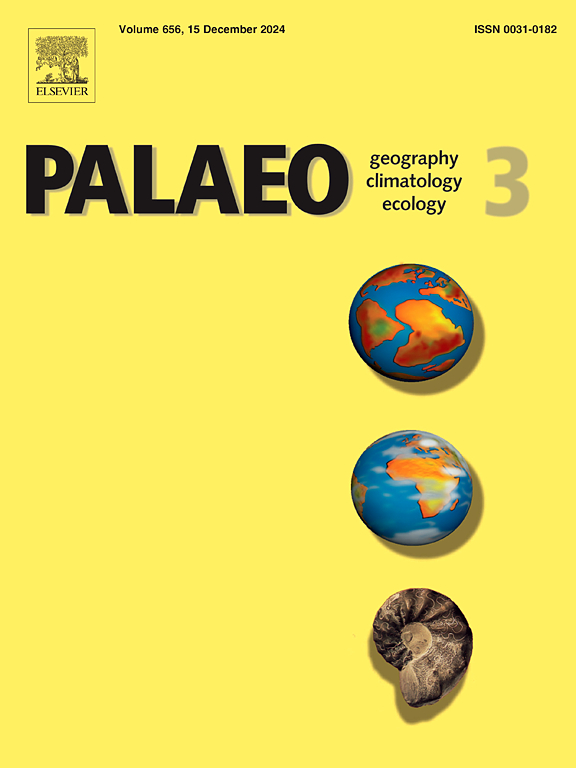Significant shifts of sedimentary environment and carbon burial during the middle Holocene on the Sunda Shelf
IF 2.7
2区 地球科学
Q2 GEOGRAPHY, PHYSICAL
Palaeogeography, Palaeoclimatology, Palaeoecology
Pub Date : 2025-05-20
DOI:10.1016/j.palaeo.2025.113052
引用次数: 0
Abstract
Changes in sedimentary environments and carbon burial exert significant impacts on regional and global environmental and climatic systems. However, the long-term evolution of sedimentary environment and carbon burial on the Sunda Shelf remains poorly understood. In this study, we analyzed the elemental geochemistry and organic carbon composition of core CJB01–64 from the central Sunda Shelf to elucidate the evolutionary history of sedimentary environments and carbon burial since the last deglaciation, as well as to reveal their controlling mechanisms and climatic-environmental implications. Our results indicate a significant shift in sediment provenance in the central Sunda Shelf around 7.5 ka. Prior to this time, sediments were primarily derived from Thai rivers and the Mekong River, whereas after 7.5 ka, sediment contributions expanded to the Mekong River, Thai rivers, and Malay Peninsula rivers. The intensity of chemical weathering on the Sunda Shelf markedly weakened after 7.5 ka, with the East Asian Summer Monsoon serving as the primary controlling factor. The sedimentary environment transitioned from a nearshore terrestrial-dominated setting to a marine-dominated regime around 7.5 ka. Furthermore, the organic carbon burial flux decreased significantly after 7.5 ka, dropping by nearly sixfold. Since the last deglaciation, organic carbon burial on the low-latitude Sunda Shelf has been predominantly regulated by sea-level fluctuations and East Asian Summer Monsoon variability, whereas high-latitude shelves exhibited carbon burial principally governed by global climatically driven processes. Notably, during low sea-level periods of the last deglaciation, the Sunda Shelf exhibited a sedimentary carbon burial flux of 8.816 Tg/a, indicating that the Sunda Shelf was a critical carbon sink during this period. Our findings highlight the Sunda Shelf's sedimentary environmental dynamics and carbon burial evolution as potential responders to and influencers of regional and global environmental and climatic changes.
巽他陆架中全新世沉积环境与碳埋藏的显著变化
沉积环境和碳埋藏的变化对区域和全球环境和气候系统具有重要影响。然而,对巽他陆架沉积环境和碳埋藏的长期演化仍知之甚少。通过对中巽他陆架CJB01-64岩心元素地球化学和有机碳组成的分析,揭示了末次冰消期以来沉积环境和碳埋藏的演化历史,及其控制机制和气候环境意义。结果表明,在7.5 ka前后,巽他陆架中部沉积物物源发生了重大变化。在此之前,沉积物主要来自泰国河流和湄公河,而在7.5 ka之后,沉积物的贡献扩大到湄公河,泰国河流和马来半岛河流。7.5 ka以后,巽他陆架化学风化强度明显减弱,东亚夏季风是主要的控制因素。7.5 ka左右,沉积环境由近岸陆相为主转变为海相为主。7.5 ka后,有机碳埋藏通量显著下降,下降了近6倍。自末次消冰期以来,低纬巽他陆架有机碳埋藏主要受海平面波动和东亚夏季风变率的调节,而高纬陆架有机碳埋藏主要受全球气候驱动过程的调节。值得注意的是,在末次消冰期的低海平面时期,巽他陆架的沉积碳埋藏通量为8.816 Tg/a,表明巽他陆架是该时期的关键碳汇。研究结果表明,巽他陆架的沉积环境动力学和碳埋藏演化是区域和全球环境和气候变化的潜在响应者和影响者。
本文章由计算机程序翻译,如有差异,请以英文原文为准。
求助全文
约1分钟内获得全文
求助全文
来源期刊
CiteScore
5.90
自引率
10.00%
发文量
398
审稿时长
3.8 months
期刊介绍:
Palaeogeography, Palaeoclimatology, Palaeoecology is an international medium for the publication of high quality and multidisciplinary, original studies and comprehensive reviews in the field of palaeo-environmental geology. The journal aims at bringing together data with global implications from research in the many different disciplines involved in palaeo-environmental investigations.
By cutting across the boundaries of established sciences, it provides an interdisciplinary forum where issues of general interest can be discussed.

 求助内容:
求助内容: 应助结果提醒方式:
应助结果提醒方式:


